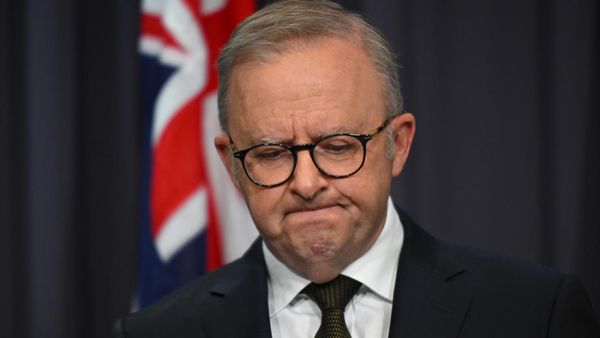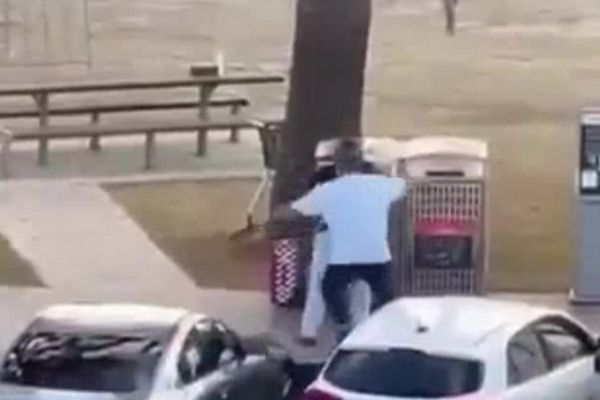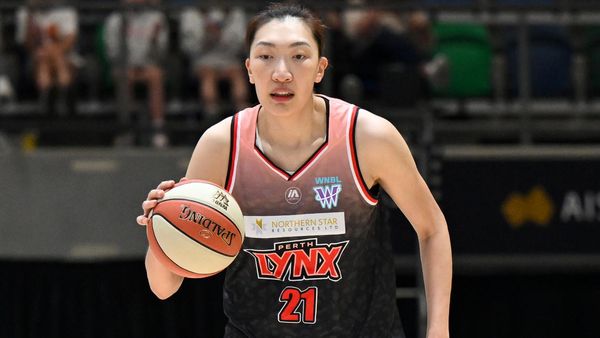
Before we sit down to talk, Alvaro Barrington gives me a guided tour of his expansive studio in Whitechapel, east London. It stands on the site of one of the country’s first free schools for the poor, which was founded in 1860. As we climb the steps to the upper floor of an ornate two-storey neo-Jacobean building that was once an assembly hall and gymnasium, he talks animatedly about the waves of immigrant workers who settled and transformed the area, from French Huguenots in the 17th century to the Jewish, Irish and Bengali communities that followed in their wake.
“I think of myself essentially as a working-class immigrant and Whitechapel chimes with that,” he says. “The long history of this planet is one of migration and exchange. That is what has given me the most freedom in terms of conceptualising myself and my journey, so I kind of feel at home here.”
Aged 41, Barrington’s own experience of migration and exchange is embedded in his vividly expressive paintings, which have made him one of the stars of the modern art scene. In a few weeks, having first grabbed the attention of the London art cognoscenti with his MFA graduate show at the Slade school of art in 2017, he will present what may well be his most important exhibition to date. Having been awarded the Tate Britain Commission, he follows in the footsteps of established artists such as Mike Nelson (2019) and Hew Locke (2022).
“It’s a huge deal for any artist,” says the London gallerist Sadie Coles, who has hosted four solo exhibitions of Barrington’s work since 2019. “No gallery show will ever have that kind of exposure or critical attention that a mega platform like the Tate provides.”
In a paint-flecked sweatshirt, baggy shorts, white socks and sandals, Barrington emits a sense of easygoing calm that is in stark contrast to the buzz of activity around him. Across several floors in a building adjacent to the old school house, there are rooms filled with paintings-in-progress, art materials and stacks of multicoloured fabrics, while a small army of youthful studio assistants flit about with purposeful intensity.
A Tate Britain press release tantalisingly trails the forthcoming Duveen installation as “a major new work addressing themes of place and belonging”. It is taking shape in the school’s former gymnasium, but Barrington is unable to discuss details before the official opening. Instead, we repair to a quiet attic room and talk about everything else under the sun, from the importance of community to the lineage of New York hip-hop.
Born in Caracas, Venezuela, to a Grenadian mother and Haitian father, Barrington was raised in Grenada by his grandmother, before moving to Brooklyn when he was eight years old. His work is loaded with memories of his Caribbean childhood landscape – blood-red hibiscus flowers are a recurring motif – as well as references to pop culture and art history. His conversation, too, is free-ranging and peppered with names that don’t often appear in the same sentence – Willem de Kooning and Tupac Shakur, Joseph Beuys and Marcus Garvey, Claude Monet and Miles Davis – but add up to a kind of cultural map of his myriad influences.
“Alvaro exists and draws on several different communities that do not often converge in the art world,” says Coles, “There’s his extended Caribbean community, the New York hip-hop community he immersed himself in in Brooklyn, but also his sense of himself belonging to an art community, whether that be the likes of Louise Bourgeois or his young friends who are also artists.”
Although Barrington defines himself as a painter, his materials speak of a similarly diverse approach to image-making, from the yarn he stretches sometimes over his canvases as a kind of homage to his grandmother’s sewing skills to the concrete on which he inscribes fragmented lyrics from the rich oral history of hip-hop culture. He describes his approach as a kind of visual “creolisation”.
Having self-funded himself through college in New York, Barrington arrived in London in 2017 as a relative unknown, but his Slade graduation show changed all that. “There was a shared feeling that this was a very powerful and dynamic new voice,” says Coles. “The fact that he was older than most of the other students meant his work had a very developed autobiographical content as well as a unique formal signature that reflected that.”
Soon after, he was given his first solo show at MoMA PS1 in New York. “It was offered to me through a DM on Instagram,” he tells me, still sounding surprised. He responded by recreating his London studio in its entirety in the New York gallery. His iconoclastic approach to exhibiting continued with a 2019 show at Thaddaeus Ropac in London. Provocatively titled Artists I Steal From, it featured a single painting by him nestling among a constellation of his influences, including work by Philip Guston, Agnes Martin and Robert Rauschenberg.
“That was probably the most important show of my life,” he says. “It was really about contextualising me in terms of all these other artists. One of the things I’m interested in is how, in the long history of painting, artists struggle to make painting make sense. By studying their work, maybe I can borrow some of their solutions and transform them.”
Since graduating, Barrington has walked to his own rhythm, creating elaborate floats and stages for the Notting Hill carnival, as well as funding community projects connected to it. “Carnival is inclusive,” he says. “It’s a celebration of community. I put my paintings on a float and a million people get to see them.” He has plans to turn the old school house into a hub for emerging artists as well as a place where the local community can feel welcome and included.
More intriguingly, Barrington has also redefined the usually monogamous relationship between artist and gallerist to an audacious degree. Currently, he has nine galleries representing him worldwide, including three in London and three in New York. “His approach is aimed towards maximising every opportunity available to him,” says Coles, “but there is also a strategy at work, wherein each gallery deals with a different aspect of his work. I’ve had his hibiscus and carnival paintings, while Blum in Los Angeles is very much about his urban, hip-hop influenced content.”
Hip-hop, Barrington tells me, was the soundtrack to his young life and remains his single most important formative influence. For his debut show at Blum, he had one of his heroes, Ghostface Killah from the Wu-Tang Clan, perform on a pop-up stage. The title of Ghostface’s song All That I Got Is You is tattooed on his left hand.
“Growing up in Brooklyn, hip-hop let me know that what I was experiencing, others were also experiencing,” Barrington says, growing visibly animated. “Biggie, Tupac, Ghostface – those guys saved my life. They are my north stars and there is a part of the Tate Britain show where I acknowledge that. That’s all I can say about it.” He pauses for a moment, as if lost in recollection. “I remember when I was a kid hearing Children’s Story by Slick Rick and I can truthfully say there would be no Tate Britain show if he hadn’t made that record.”
When I ask Barrington how he felt when he landed the Tate commission, his answer is characteristically thoughtful. “I felt honoured, but I saw it more as an opportunity than an accolade. And with every opportunity, there is also the bigger question, what does this mean?”
So what does it mean to him? He pauses for a long moment. “Well, I’ve lived in London for nearly a decade, but I think of myself as an American. Then there’s the fact that I grew up in Grenada, which is a part of the Commonwealth of the United Kingdom. I can remember seeing the Queen’s face on a bill for the first time when I was five years old. So, the first question is, what is my relationship to all of this and how do I explore it? The Tate show is a great opportunity to think through all of that. That’s the exciting part.”







